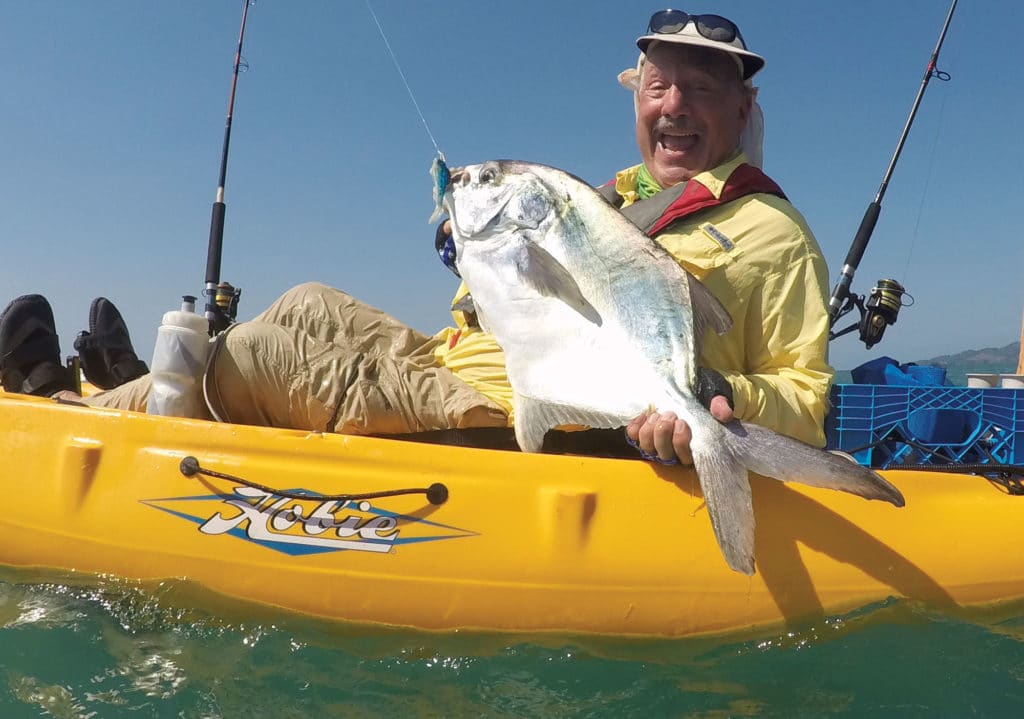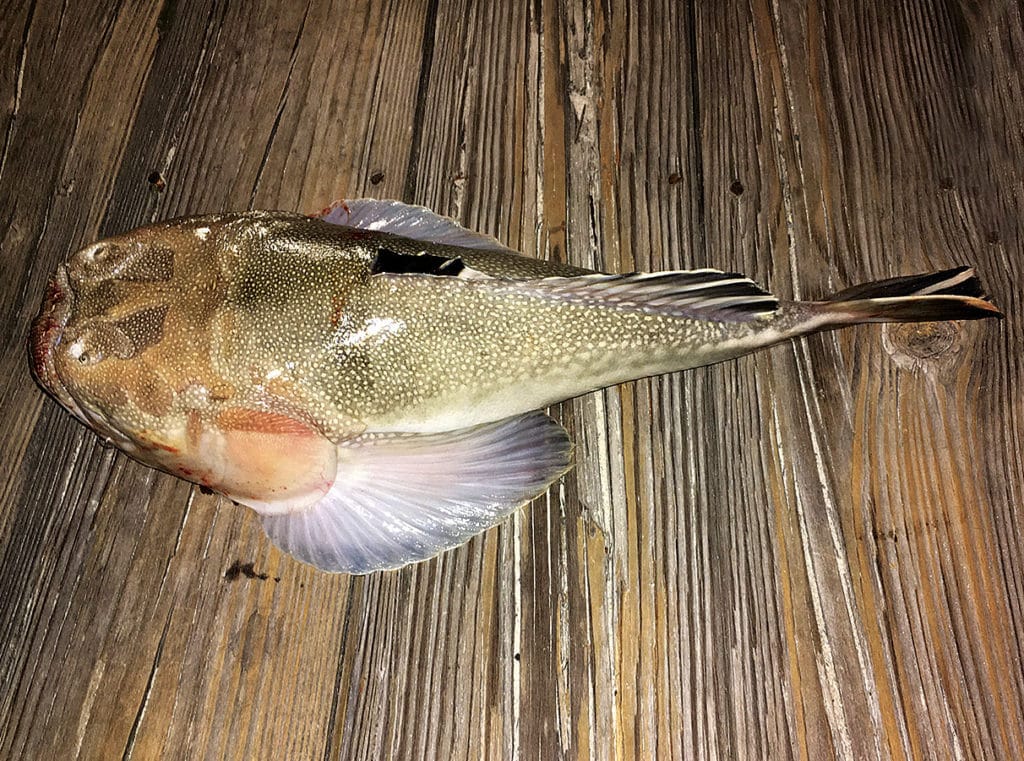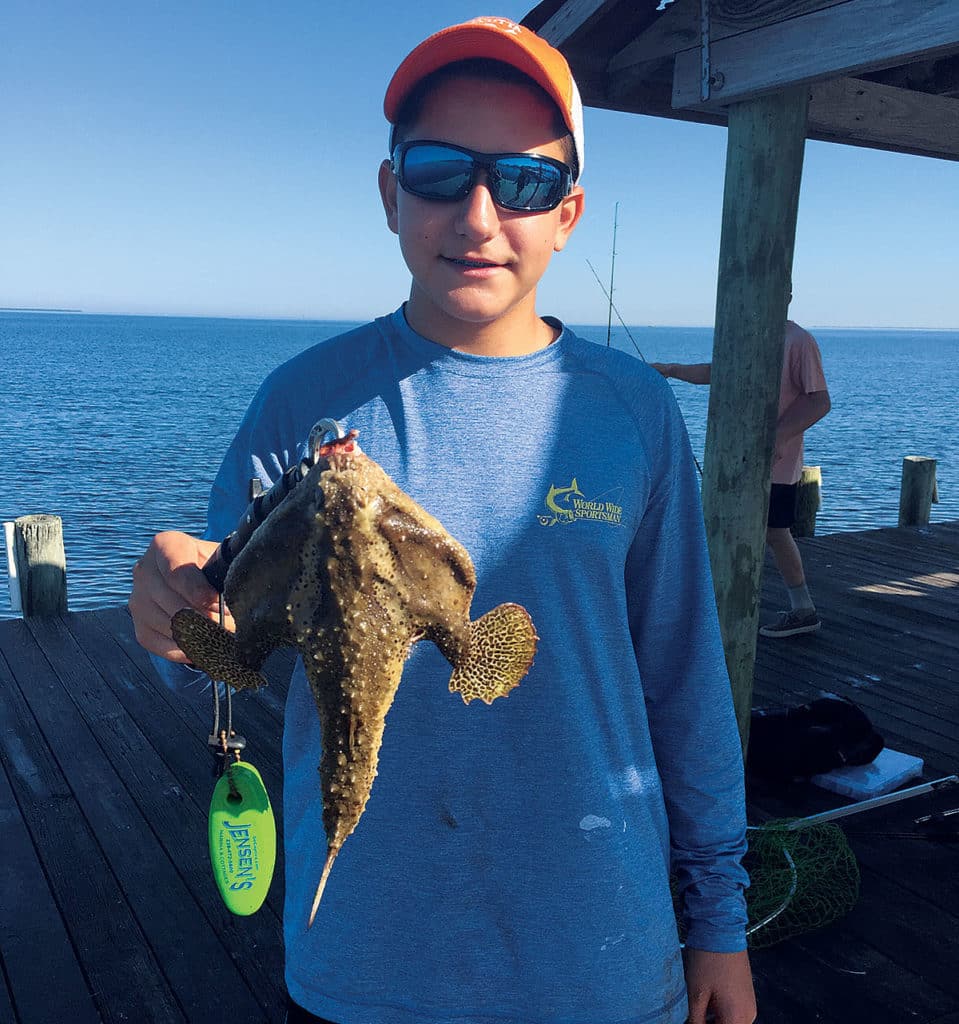Panama Pompano
QUESTION:
We caught some African pompano while kayak-fishing off Panama. This isn’t that, though I’d guess it to be in the same family (jacks and trevally). What exactly did I catch?
Mitchell Roffer
Melbourne, Florida

ANSWER:
This is likely the paloma pompano, Trachinotus paitensis, Mitch. These are particularly abundant in lagoons where they may be one of the most important predatory fishes. However, anglers often encounter larger individuals along the open coast, mostly in schools along sandy beaches, but occasionally down to depths of more than 300 feet. Palomas grow to 20 inches long and occur from Redondo Beach, Southern California, to Chile, including the Gulf of California and Islas Galapagos. There is no world record established at this point. I have found such invertebrates as snails, shrimp and crabs, along with the occasional small fish, in their stomachs. In some areas, this species forms a substantial part of the commercial artisanal fishery. Arguably, this is one of the best tasting of the pompanolike species.
—Milton Love
Checker This Out
QUESTION:
I caught this fish on light tackle close to Cambodian territorial waters, in the Gulf of Siam. The bait was a piece of squid offered on the bottom. It must be some sort of snapper, but what type?
Capt. Jean-Francois Helias
anglingthailand.com
Bangkok

ANSWER:
What you have there is a checkered snapper, Lutjanus decussatus, a member of the Lutjanidae family. This species occurs throughout tropical western Indo-Pacific waters, from the Ryuku Islands near Japan, down to northern Australia, and as far west as India and Sri Lanka. The checkered is one of the smaller lutjanids, growing to only around 14 inches. Its name comes from its distinctive color pattern, which includes the “checker board” on the upper half of the body, plus five to six horizontal brown stripes along the flanks, and a prominent black spot at the base of the tail. Like other small tropical snappers, adult checkered snapper inhabit structures around inshore and offshore coral reefs to depths of 100 feet, often occurring in schools, while the juveniles frequent coral patches on shallow reef flats. They are aggressive feeders, preying on smaller fishes and benthic crustaceans such as shrimps and crabs.
—Ben Diggles
Count Your Lucky Stargazers
QUESTION:
I caught this fish at night while casting from a pier in the Chesapeake Bay. The water was about 3 feet deep. I believe it is a northern stargazer, but no one around here has ever seen one. Is this normally a shallow-water fish?
Steve Loomis
Cape Charles, Virginia

ANSWER:
Steve, that is indeed a northern stargazer, Astroscopus guttatus. Its range is from New York to North Carolina, occurring in bays, coastal waters and the continental shelf as deep as 600 feet. It’s one of the few truly endemic fish species in the Middle Atlantic Bight. Not only is your specimen a shallow-water fish, it spends so much time buried in the substrate that you might say it’s a below-shallow-water fish. Its eyes are situated on top of the head, protruding only when the fish buries itself in sand, mud or any soft substrate. The species can exceed 10 pounds (the all-tackle world record stands at 10 pounds, 12 ounces, caught off New Jersey in 1998).
This species is most often seen when there are local oxygen-depletion events with resulting fish kills, at which time they make up a large percentage of affected fish, in areas where local folks don’t even know they exist. They’re seldom collected in trawl samples. Reproduction occurs in summer, and the larvae and early juveniles are seen (by biologists) more often than the adult stages. Winter is apparently spent on the bottom near the edge of the continental shelf, but data on their winter distribution is incomplete.
—Mike Fahay
Hawaiian Tuna Shows Its Stripes
QUESTION:
We caught this small tuna, held for a photo by my deckhand Britt McCurdy, off Kona. We’re accustomed to various small tunas here — such as skipjacks, kawakawa and frigate mackerel — but we don’t see many striped bonito like this. What is it exactly?
Capt. Shawn Rotella
Night Runner Sportfishing
Kailua-Kona, Hawaii

ANSWER:
You’re exactly right, Shawn: It’s a striped bonito, otherwise known as the oriental bonito, Sarda orientalis. Of the five recognized species of bonitos, this is the most widely distributed, found throughout the tropical and subtropical waters of the entire western Indo-Pacific region, from the Pacific coast of the United States and Central America, west through the Galapagos and Hawaiian Islands (where they’re reportedly rare), and throughout the western Pacific to Japan, northern Australia and across the Indian Ocean to eastern Africa.
The oriental can be distinguished from the other four bonito species by various minor morphological features such as differences in finlets, teeth and vertebral counts, and the arrangement of the distinctive longitudinal stripes, which are quite thin and straight on this species and do not extend onto the belly. In contrast, the Atlantic bonito (Sarda sarda) has slightly diagonal stripes at a more oblique downward angle, while the stripes on the Australian bonito (Sarda australis) are much broader and extend far below the lateral line and onto the belly. The other two species of bonito occur only in the Eastern Pacific, including the aptly named east Pacific bonito (Sarda chilensis), which occurs along the coasts of Chile and central America, and the Pacific bonito (Sarda lineolata), found along the West Coast of the United States from Alaska to Baja California. Both of the latter species are closely related and, compared with the oriental bonito, have fewer stripes that tend to be slightly wavy and more widely spaced.
Like its other close relatives, the oriental bonito is an epipelagic species that schools by size (including with other similar-size tunas) and spends most of its time feeding voraciously on smaller fishes, squids and shrimp. With a life span of less than 10 years, it matures in its second year, growing quickly to a maximum size of around 40 inches and 23 pounds.
—Ben Diggles
On the Trail of the Yellow Tail
QUESTION:
One of my customers caught this small fish while bottomfishing for northern kingfish behind the southern point of Assateague Island, Virginia. We were over sandy bottom in less than 10 feet of water. At first I thought it was a Florida pompano, but the head shape is different, so I am going with some other kind of jack. Your thoughts?
Capt. Charlie Koski
Chincoteague Island, Virginia

ANSWER:
Your client caught a juvenile blue runner, Caranx crysos, Charlie. Unlike adults, juveniles of this species have yellow median (dorsal, anal and caudal) fins and a series of broad, dark bands on their sides. Although faded, these bands can be seen on the fish in question. Additionally, unlike some other Atlantic members of the family Carangidae (the jacks), blue runners have a dark blotch by the upper posterior margin of each operculum, and this is apparent on the fish in your photographs. Finally, the fish lacks adipose eyelids, which are characteristic of yellow jacks (C. bartholomaei) and bar jacks (C. ruber), similarly shaped species that also have yellow median fins as juveniles. Juvenile blue runners often form schools and are easily caught on sabiki or quill rigs or small jigs or shrimp-tipped hooks. They make excellent live bait for pelagic species including king mackerel (Scomberomorus cavalla) and sailfish (Istiophorus platypterus). Unfortunately, larger individuals are quite strong-tasting, which limits their appeal to many human would-be consumers. The maximum size achieved by blue runners is slightly more than 2 feet (the all-tackle record was an 11-pound, 2-ounce fish from the northern Gulf of Mexico in 1997), although the average size is considerably smaller. In the Western Atlantic, the blue runner ranges from Nova Scotia through Brazil, including Bermuda, the Bahamas, the Caribbean Sea and the Gulf of Mexico.
—Ray Waldner
Going Batty
QUESTION:
Last week my nephew, Joseph Sabella, caught a strange-looking fish that I’ve never seen before. I think it’s called a polka-dot batfish. It weighed about 2 pounds. Joe caught it on the Bokeelia Pier in southwest Florida.
Sal Sabella
Coral Springs, Florida

ANSWER:
Sal, indeed what your nephew caught was a polka-dot batfish, Ogcocephalus radiatus, a truly fascinating fish. These guys, along with about a half-dozen other species of batfishes found along our coasts, are quite common but rarely seen. This is because their feeding habits generally preclude getting hooked: Under that pointed snout is a small cavity that contains a highly modified dorsal fin called an illicium, which it can wiggle like a tiny worm. This attracts small prey animals, which it then engulfs. It is also thought that the batfish produces a chemical attractant that helps to draw in other living food items. So catching a batfish with a hook is highly unlikely (but obviously possible).
These menacing-looking creatures are totally harmless. Divers often encounter batfish on open sandy bottom and can easily pick them up since they’re terrible swimmers because their fins are used more for walking than swimming. They would likely be fascinating aquarium residents except for those difficult feeding habits.
The polka-dot batfish ranges along our coasts from North Carolina around Florida and into the northeastern Gulf. They top off at about a foot and weigh in at about a pound or two. Though most common in shallow depths, they’ve been found to several hundred feet.
—Bob Shipp
Read Next: Strange Fishes from the Deep — Jelly-Eating Prowfish and More
Sport Fishing‘s Prestigious International Panel of Experts
Northeast
Mike Fahay, Sandy Hook Marine Lab, New Jersey
Southeast
Ray Waldner, Ph.D., Palm Beach Atlantic University, Florida
Gulf of Mexico
Bob Shipp, Ph.D., University of South Alabama
West Coast
Milton Love, Ph.D., UCSB, California
Far Pacific
Ben Diggles, Ph.D., Queensland, Australia
Bluewater Pelagics
John Graves, Ph.D., Virginia Institute of Marine Science

CHALLENGE OUR EXPERTS (And Win Up to 10,800 Yards of Line!)
Send in your question and any relevant photos of your mysterious catch or observation for our experts’ ID and feedback. If we publish your question and you have a shipping address within the United States or Canada, you’ll win a 3‑pound spool of Berkley Pro Spec ocean-blue or fluorescent-yellow monofilament (1,000 to 10,800 yards, depending on line strength) or a 1,500‑yard spool of Spiderwire Stealth braid up to 100‑pound‑test! Send questions and images via email to fishfacts@sportfishing.com (include your hometown) or via post to Sport Fishing Fish Facts, 460 N. Orlando Ave., Suite 200, Winter Park, FL 32789.








